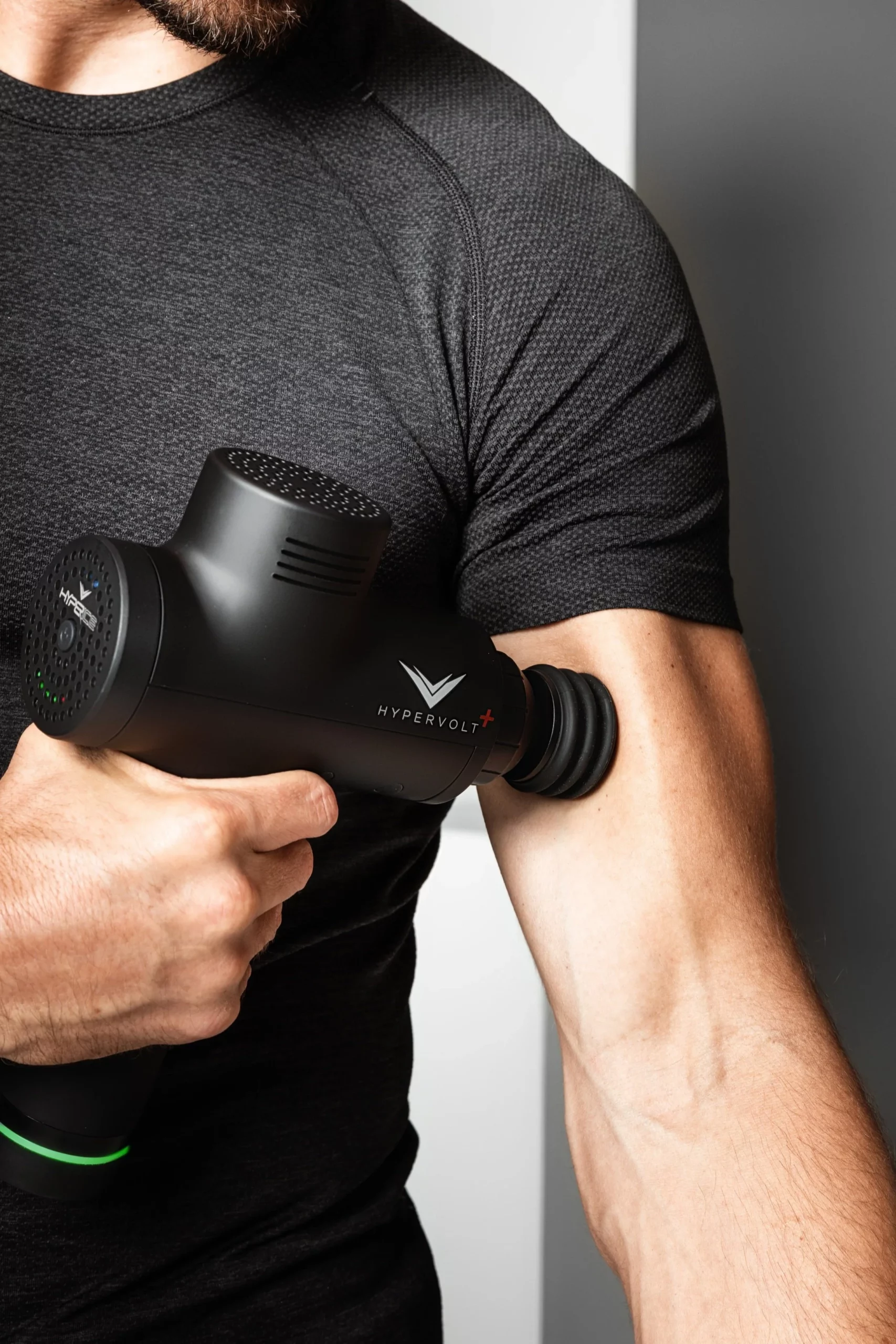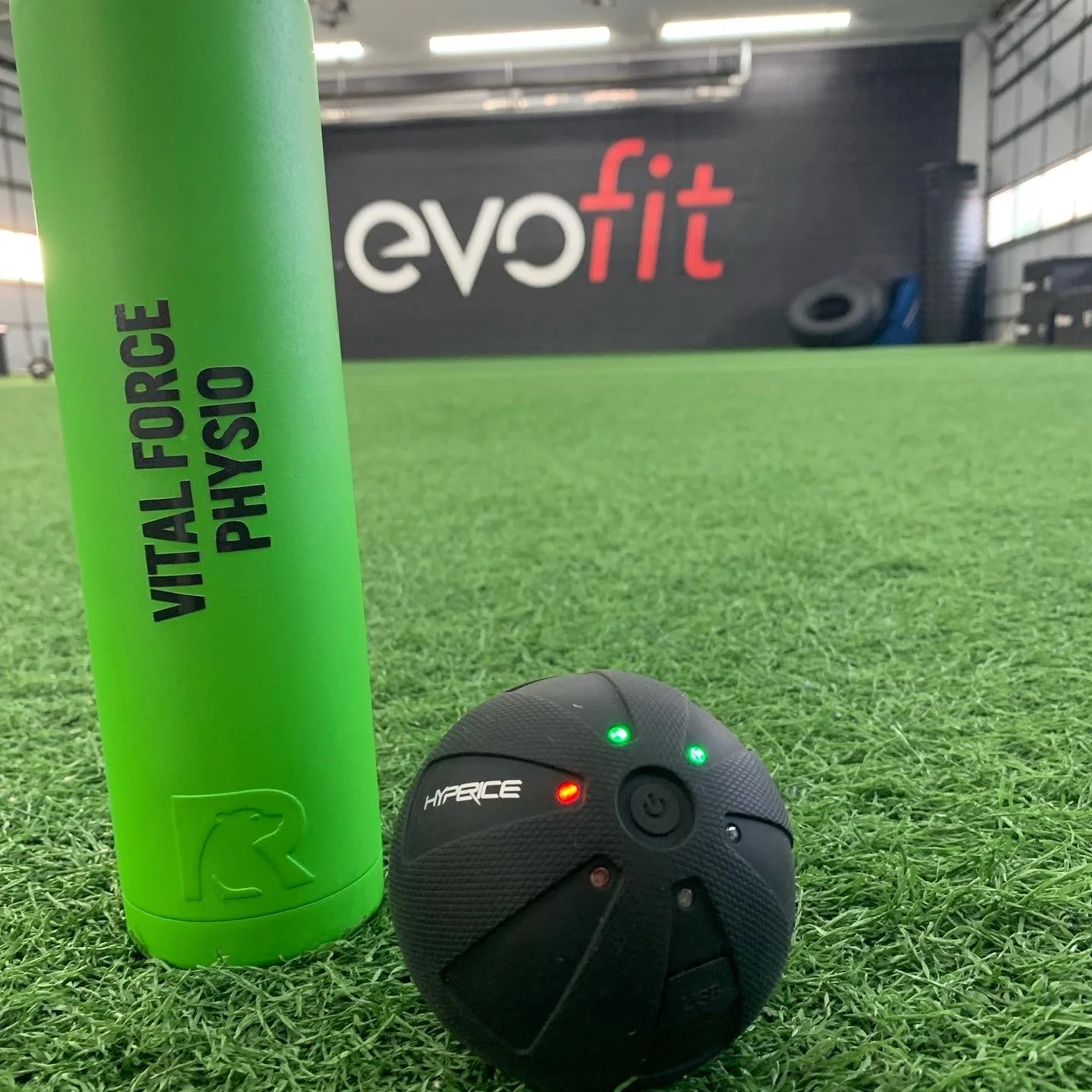The benefits and science behind the popular vibration devices seen in many gyms, physical therapy clinics and athletic facilities
Percussion or vibration therapy has become increasingly popular in physical therapy clinics, on the sidelines at sporting events and at fitness facilities. You may see the devices in the form of massage guns, vibrating foam rollers or pulsating spheres. But why are athletes and active individuals using these new tools? The simple answer is “to optimize movement and performance.” But how? Keep reading to discover the benefits of percussion massage and how to use it effectively in your training and recovery routine.

Percussion massage therapy combines traditional soft tissue massage with pulsations or vibrations of up to 57Hz (3). One of its touted benefits is decreased DOMS (Delayed Onset Muscle Soreness). DOMS typically occurs 24-48 hours after exercise and is commonly felt by individuals when they perform at higher intensities than normal or with eccentric exercise in their training program (1). Subsequent athletic and fitness performance is often altered by DOMS via decreased muscle contractility, reduced joint range of motion and impaired flexibility. The use of percussion massage therapy has been shown to minimize the negative effects of DOMS by increasing blood flow, increasing intramuscular temperature, decreasing perception of pain, and improving relaxation (2,3). To realize these affects, studies have shown that just 2-5 minutes of vibration therapy is needed before or after performance/activity (3).

Percussion massage therapy combines traditional soft tissue massage with pulsations or vibrations of up to 57Hz (3). One of its touted benefits is decreased DOMS (Delayed Onset Muscle Soreness). DOMS typically occurs 24-48 hours after exercise and is commonly felt by individuals when they perform at higher intensities than normal or with eccentric exercise in their training program (1). Subsequent athletic and fitness performance is often altered by DOMS via decreased muscle contractility, reduced joint range of motion and impaired flexibility. The use of percussion massage therapy has been shown to minimize the negative effects of DOMS by increasing blood flow, increasing intramuscular temperature, decreasing perception of pain, and improving relaxation (2,3). To realize these affects, studies have shown that just 2-5 minutes of vibration therapy is needed before or after performance/activity (3).
Performance
But what about sport and fitness performance? There is some debate in the literature on the effects of percussion massage on enhancing muscular activity prior to exercise and athletic events. Konrad et. al, found that utilizing massage devices improved ankle mobility but did not change maximal muscle contraction of the lower leg. Alternatively, Lee et. al, demonstrated that leg muscle strength was enhanced with use of vibration therapy as compared to static stretching. Both studies demonstrate that using vibrating devices provides working muscles with the appropriate environment to contract and move efficiently. Therefore, if used appropriately they can effectively prepare athletes for sport, gym goers for their workouts and rehabilitate injured humans.
How to perform percussion massage
Performing percussion massage is quite simple. First, choose a method of vibration therapy. This could be either a vibrating massage gun, foam roller or ball, to name a few. Next, locate a tight or sore area of muscle tissue (be sure to stay away from boney prominences, this tool is not meant to move over bone!). Hold the pulsation device over your targeted area for approximately 30 seconds to accommodate to the stimulus. Once you have good tolerance to the pressure, you can increase the intensity and move to other areas.
There are many techniques to utilize when performing percussion massage. One of our favorites at Vital Force Physio is that of “contract-relax.” First, simply locate an area of muscle restriction as described above. Then, while maintaining pressure over the area, contract the targeted muscle for 5 seconds. Relax and repeat. This technique allows the muscle to experience deeper relaxation for improved mobility and performance.

Percussion massage therapy is a great tool to add to any strength program, flexibility routine, physical therapy treatment or workout. Athletes and active individuals looking for a way to enhance recovery should consider percussion devices to excel at sport and life.

For more information on how to improve your performance and decrease pain, contact Dr. Bryan Vranic at Vital Force Physio, where he frequently utilizes percussion devices to help active individuals and athletes outperform their pain.

Movement is Vital for a healthy body and Your Body is a Force to be reckoned with,
Dr. Bryan Vranic, PT, DPT, CSCS
This information is not intended to be used as medical advice but for educational purposes only. Please consult your Physical Therapist, Physician or Healthcare Provider for more information.
References
1. Cheung K, Hume P, Maxwell L. Delayed onset muscle soreness : treatment strategies and performance factors. Sports Med. 2003;33(2):145-164. doi:10.2165/00007256-200333020-00005
2. Davis HL, Alabed S, Chico TJA. Effect of sports massage on performance and recovery: a systematic review and meta-analysis [published correction appears in BMJ Open Sport Exerc Med. 2021 Apr 21;7(2):e000614corr1]. BMJ Open Sport Exerc Med. 2020;6(1):e000614. Published 2020 May 7. doi:10.1136/bmjsem-2019-000614
3. Konrad A, Glashüttner C, Reiner MM, Bernsteiner D, Tilp M. The Acute Effects of a Percussive Massage Treatment with a Hypervolt Device on Plantar Flexor Muscles’ Range of Motion and Performance. J Sports Sci Med. 2020;19(4):690-694. Published 2020 Nov 19.
4. Lee CL, Chu IH, Lyu BJ, Chang WD, Chang NJ. Comparison of vibration rolling, nonvibration rolling, and static stretching as a warm-up exercise on flexibility, joint proprioception, muscle strength, and balance in young adults. J Sports Sci. 2018;36(22):2575-2582. doi:10.1080/02640414.2018.1469848


